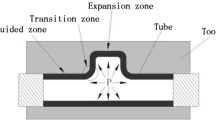Abstract
Owing to the advantages of favorable forming stiffness, light weight, and high production efficiency, hydroforming technology has extensive application prospects in the automobile and aerospace fields. This study designs and develops an experimental test system, which continuously injects oil into a quartz tube with favorable transparency, and then captures the flow characteristics of the liquid in the tube in real time using an ultra-high-speed camera. The fluid–solid coupling method of the MSC.Dytran finite element software is used for the experiment. The correctness of the simulation analysis method is verified by comparing the experimental and simulation results. Thus, a hydraulic bulging experiment of 20# steel tube without axial feed and a simulation analysis of the hydraulic bulging process of the rectangular section tube through the fluid–solid coupling method were conducted. A comparison between the experimental and simulation results verified the correctness of the finite element modeling and numerical calculation. In addition, the effects of forming pressure, loading time, and hydraulic loading path on wall thickness change in fillet filling was studied. Results showed that pressure drop exists in the pipe, and the velocity of the fluid changes rapidly with the deformation. The forming pressure clearly influences the forming effect. The maximum thinning rate of the middle section wall thickness initially decreases and then increases given an extended hydraulic loading time. Therefore, the optimal loading time should be determined to achieve the optimal forming effect. The effect of hydraulic loading path on the thickness reduction of wall thickness is not apparent but significantly influences the uniformity of wall thickness distribution.
Similar content being viewed by others
References
Fatemi A, Morovvati MR, Biglari FR (2013) The effect of tube material, microstructure, and heat treatment on process responses of tube hydroforming without axial force. Int J Adv Manuf Technol 68(1–4):263–276. https://doi.org/10.1007/s00170-013-4727-1
Khalfallah A (2014) Experimental and numerical assessment of mechanical properties of welded tubes for hydroforming. Mater Design 56:782–790. https://doi.org/10.1016/j.matdes.2013.11.051
Tijsseling AS, Vardy AE (2005) Fluid-structure interaction and transient cavitation tests in a T-piece pipe. J Fluid Struct 20:753–762. https://doi.org/10.1016/j.jfluidstructs.2005.01.003
Siyuan C, Hailiang H, Linjie W (2016) Influence of installed interlayers on defensive efficiency of a warship’s liquid cabin. J Harbin Engineering University 37(04):527–532. https://doi.org/10.11990/jheu.201412040
Han C, Feng H, Yan LD, Yuan SJ (2015) Thickness improvement in non-homogeneous tube hydroforming of a rectangular component by contact sequence. Int J Adv Manuf Technol 97:42–49. https://doi.org/10.1007/s00170-017-0362-6
Fengjun C (2009) Study on the deformation behavior of a tube in hydroforming with radial crushing. Guilin University of Electronic Technology, Guilin
Labergere C, Gelin JC (2012) Numerical simulation of sheet hydroforming taking into account analytical pressure and fluid flow. J Mater Process Technol 212(10):2020–2030. https://doi.org/10.1016/j.jmatprotec.2012.05.002
Gang L, Junyang P, Shijian Y, Bugang T, Kai L (2015) Analysis on critical conditions of sidewall wrinkling for hydroforming of thin-walled Tee-joint. Int J Mach Tool Manu 97:42–49. https://doi.org/10.1016/j.ijmachtools.2015.06.004
Haitao J, Zhenli M, Di T, Haiquan W, Yongjuan D (2008) In-situ observation of microstructure in TWIP steel during tensile deformation. J Mater Eng 38(1):38–41. https://doi.org/10.3969/j.issn.1001-4381.2008.01.010
JiSeok L, JaeHo S, SangHwan L (2012) Fluid-structure interaction of a flapping flexible plate in quiescent fluid. Comput Fluids 57:124–137. https://doi.org/10.1016/j.compfluid.2012.10.029
Mirzaali M, Seyedkashi SMH, Liaghat GH, Naeini HM, Shojaee GK, Moon YH (2012) Application of simulated annealing method to pressure and force loading optimization in tube hydroforming process. Int J Mech Sci 55:78–84. https://doi.org/10.1016/j.ijmecsci.2011.12.005
Rakesh AS, Bhushan TP, Ketaki NJ (2016) Optimization of tube hydroforming process (without axial feed) by using FEA simulations. Procedia Technol 23:398–405. https://doi.org/10.1016/j.protcy.2016.03.043
Eftekhari-Shahri SE, Ahmadi-Boroughani SY, Khalili K, Kang BS (2015) Ultrasonic tube hydroforming, a new method to improve formability. Procedia Technol 19:90–97. https://doi.org/10.1016/j.protcy.2015.02.014
Zribi T, Khalfallah A, BelHadjSalah H (2013) Experimental characterization and inverse constitutive parameters identification of tubular materials for tube hydroforming process. Mater Des 49:866–877. https://doi.org/10.1016/j.matdes.2013.02.077
Yang W, Hongyu W, Xiang Z, Xiaomin X (2011) Strength analysis on stamping and welding impeller in centrifugal pump based on fluid-structure interaction theorem. Trans CSAE 27(3):131–136 https://doi.org/10.3969/j.issn.1002-6819.2011.03.025
Xie WC, Han C, Chu GN, Yuan SJ (2015) Research on hydro-pressing process of closed section tubular parts. Int J Adv Manuf Technol 80:1149–1157. https://doi.org/10.1007/s00170-015-7126-y
Xianghe X, Shuhui L, Weihang Z, Zhongqin L (2009) Analysis of thickness distribution of square-sectional hydroformed parts. J Mater Process Technol 209(1):158–164. https://doi.org/10.1016/j.jmatprotec.2008.01.034
Xiaolei C, Xiaosong W, Shijian Y (2014) Deformation analysis of double-sided tube hydroforming in square-section die. J Mater Process Technol 214(7):1341–1351. https://doi.org/10.1016/j.jmatprotec.2014.02.005
Yumei Z, Junxiang L (2013) Investigation of wrinkle and fracture limits of cylindrical parts in hydromechanical deep drawing process. Hot Working Technol 42(1):87–90
Hu ZL, Wang XS, Pang Q, Huang F, Qin XP, Yuan SJ, Hua L (2015) Experimental and numerical study on hydroforming characteristics of friction stir welded aluminum alloy tubes. Int J Adv Manuf Technol 80:959–969. https://doi.org/10.1007/s00170-014-6613-x
Funding
This study is supported by the Guangxi Natural Science Foundation (Grant No. 2016GXNSFAA380211); Guangxi Innovation-driven Development Project (Grant No. GKAA17204062); and Liuzhou Scientific Research and Technology Development Plan (Grant No. 2016C050203).
Author information
Authors and Affiliations
Corresponding author
Additional information
Publisher’s note
Springer Nature remains neutral with regard to jurisdictional claims in published maps and institutional affiliations.
Rights and permissions
About this article
Cite this article
Su, H., Li, J., Rong, J. et al. Analysis of tubes with rectangular section forming process by fluid–solid coupling method. Int J Adv Manuf Technol 102, 2491–2509 (2019). https://doi.org/10.1007/s00170-019-03340-x
Received:
Accepted:
Published:
Issue Date:
DOI: https://doi.org/10.1007/s00170-019-03340-x



